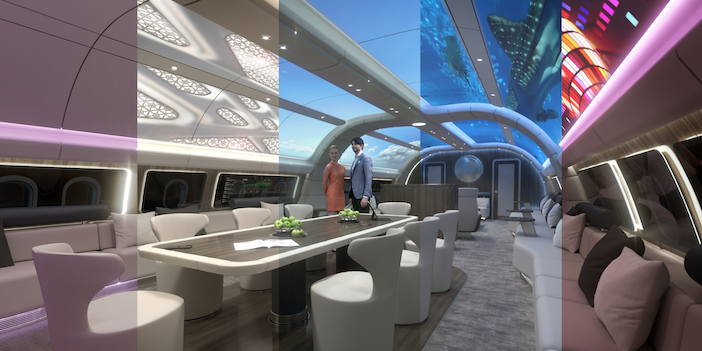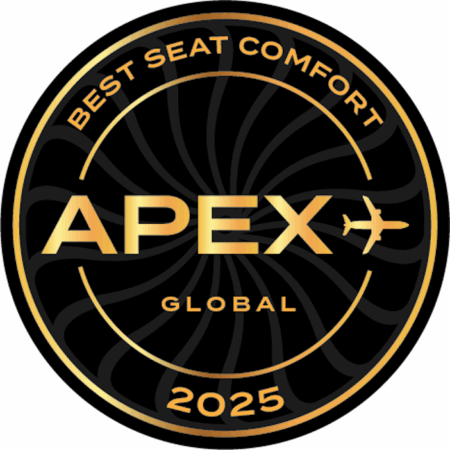Much like the wider aviation industry, the annual Crystal Cabin Awards scheme, the foremost international prize for innovation in the aircraft cabin, has had a challenging period over the past two years. However, human spirit perseveres, as does innovation, and the event is back to full strength for 2022, with an impressive shortlist of challengers, and an in-person prizegiving ceremony on 14th June in Hamburg.
The shortlist includes entries from a broad spectrum of designers, manufacturers, engineers, academia and visionaries, all with different ideas but the common goal of improving the future aircraft passenger experience. The shortlisted ideas are now being assessed by the international expert jury (including editor Adam Gavine), ahead of a final viewing when it will be decided who will raise the aviation industry’s most coveted trophies this year.
Efficient cabin spaces
The aircraft cabin is well known for being perhaps the most expensive real estate in the world, so aviation industry innovators are constantly seeking out new ways to exploit the limited space available. Unproductive space represents a very expensive missed opportunity, and especially post-pandemic, airlines need to be even more efficient with their cabin layouts.
This issue is addressed in various entries on the 2022 shortlist, including concepts like Elevate, an entry by Teague and Nordam, who have collaborated on a “floating furniture” strategy designed to bring widebody comfort to the single-aisle business class cabin: important given the growing focus on long-range narrowbodies.

Another entry has already been big news this year: AirLounge, Finnair’s new long-haul business class. The airline worked with Collins Aerospace, PriestmanGoode and Tangerine to produce a simple yet disruptive design that gives a cocoon-like experience without requiring features such as seat recline. You can read the full story behind AirLounge HERE.

This year’s shortlist also sees multiple entries taking a clean-sheet approach to cabin accommodation. Many focus on foldable, reconfigurable elements that allow airlines and passengers alike to reconfigure their expectations of how aircraft cabins use the available space.
An example is an entry by student Jiayi Yu from the University of Reutlingen. The Shift Cabin Interior study allows seats to be configured in multiple positions for work or relaxation, both along the axis of the seat as well as to the side. The concept also offers airlines an enticing prospect: to fit more seats into the same business class cabin space, increasing revenue potential.

Meanwhile, Mmillenniumm describes its AirSleeper aircraft seating concept as a seat architecture that leverages the available space and passenger ticket price in new ways. Each passenger is provided with a seat that can be folded into a flat bed, accompanied by multiple surfaces both at seat level and above passengers’ heads.
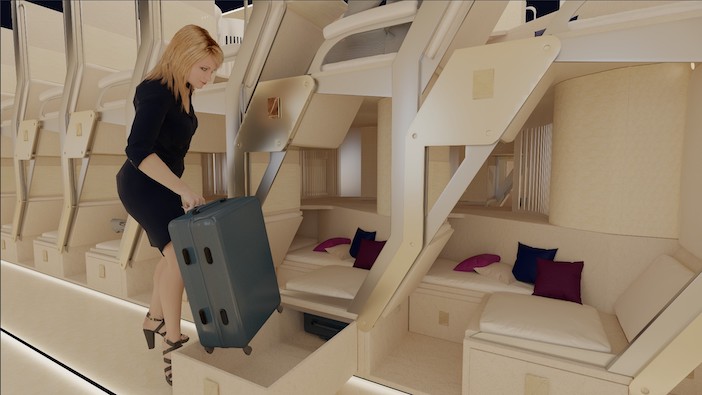
Another entry takes some inspiration from traditional train compartment seating. NeXtGC by the German Aerospace Center gives the “group of 6” a surprising new twist. The designers created a modular concept that attaches two facing rows of three seats to the sidewall and the floor, as well as to a rail system in the ceiling area, freeing up the space usually reserved for overhead bins. Stowage is also provided below the seats for faster passenger in- and egress, while the option to turn the seating into a sleeping area adds a flexible component.
Safety first: and it’s not just Covid now
The cabin industry has long had an interest in hygiene, but the Covid-19 pandemic heightened concerns about airborne pathogens. Several manufacturers have been working on clever ideas to minimise the potential spread of Covid-19 in the aircraft cabin – or any other infectious disease for that matter.
Teague again appears in the shortlist with AirShield, a design being brought to production by Pexco Aerospace. AirShield attaches to the existing PSU rail to direct airflow between passenger spaces, reducing the chance of catching an infection.
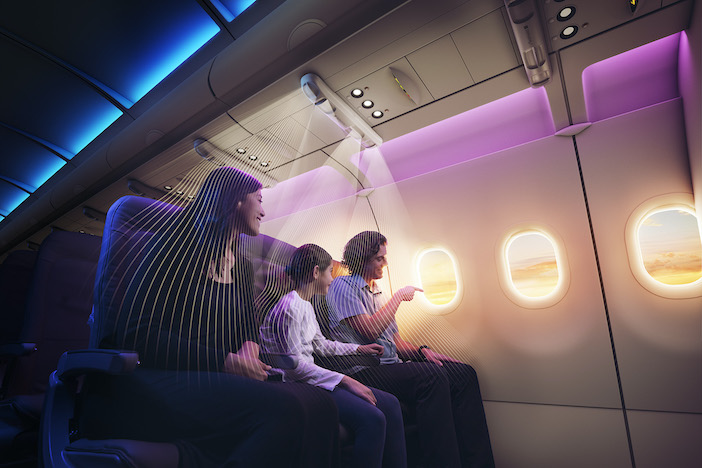
In a similar vein, Weigele Aerospace’s Vientum clean air system takes techniques proven to suppress the spread of pathogens on the ground in areas such as school classrooms, and applies them to the aircraft cabin space.
While Covid-19 has been such a big topic over the past two years, there are of course many other health and safety aspects to consider in the aircraft. For example, faulty lithium ion batteries, as found in digital devices, can be a danger in the cargo hold. In response Safran Cabin has developed the Fire Resistant Cargo Container, which can inhibit Category D fires for six hours. In the event of a container fire, that gives the flight crew valuable additional time to land safely.
One safety system on the shortlist has perhaps an unexpected benefit. Caeli Nova says that its Cordillera emergency oxygenation system could, if implemented globally, save 1.2m tonnes of CO2 emissions annually.
Sustainability in focus
Sustainability is one of the hottest topics today, both on the ground and in the sky, and a raft of entries for the 2022 Crystal Cabin Award are focused on making the passenger experience ‘greener’.
In the area of cabin materials, ELeather’s Essence solution recycles leather waste to produce its upholstery and save on raw materials, while Switzerland’s Lantal Textiles – in cooperation with Tenerías Omega and Olivenleder – has introduced a wet-green tanning process for its leather fabrics, using vegetable oils instead of chrome- and gasoline-based chemicals. Aircraft seat cushion maker Metzo, in cooperation with The Vita Group, has submitted a recycling system for used aircraft seat cushions.
Waste and weight reduction will continue to be an arena where industry development is at its most intense. Airbus Operations has engineered a technology-driven solution designed to tackle the problem of passenger food waste. Its AI-based Airspace Food Scanner captures data about passengers’ food consumption, producing valuable data for airlines to adapt their catering services to better match customer demand.
Recaro Aircraft Seating is competing with a modular, lightweight plug-in seat table system that is not only made from sustainable materials, but is lightweight reduction. Recaro says that if an airline switched to these tables on 50 aircraft, that could save 1,000 tons of CO₂ annually.
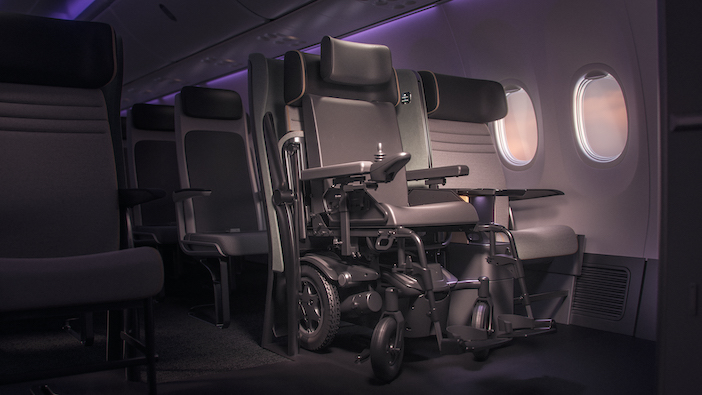
Aircraft cabins: a digital space
In the information age, safety encompasses an increasingly wide cross-section of the air travel experience. Digital and physical security are two needs addressed by Gentex Corporation’s proposal for an iris biometric scanning system. Its engineers envisage an aircraft-wide system, for example authenticating crew when entering the cockpit, or implemented in a seatback device to personalise passengers’ media or shopping offerings.
Airlines’ in-cabin digital offerings are also becoming a hotbed of innovation. The KrisShop on KrisWorld inflight shopping platform is a novel approach by Singapore Airlines, Airfree and Thales that shows that the future of passenger retail will go far beyond the usual well-thumbed seatback catalogue. Touted as the world’s first inflight eShopping experience on a seatback IFE system, KrisShop on KrisWorld lets passengers browse a digital catalogue, buy in real time using a credit card and arrange delivery, either somewhere along their travel route or back at home.
Meanwhile AerQ’s engineers have submitted Aerena, a platform to help airlines quickly and cheaply adapt onboard apps to personalise their customers’ digital experience, while reducing development costs.
Noise-cancelling headsets have proved popular with frequent flyers in recent years. ACM Aircraft Cabin Modification’s MYZONE is an idea to do away with headphones though, applying active noise cancellation (ANC) technology to the headrest and beyond. Compatible with any aviation seat, the designers say that the system can also use window panels and other cabin elements as a loudspeaker, attaining a sizeable 3dB reduction in aircraft noise.
How it works
The Crystal Cabin Award, an initiative of cluster Hamburg Aviation, has gathered entries across eight categories: Cabin Concepts, Cabin Systems, Health & Safety, IFEC & Digital Services, Material & Components, Passenger Comfort, Sustainable Cabin, and University.
For each category, the 28 expert members of the jury select three finalists, which will be announced at the beginning of May 2022. The finalists get to pitch their concepts to the jury in person at the world’s leading trade show for aircraft cabins, Aircraft Interiors Expo (14th – 16th June 2022 in Hamburg). The winners of the 2022 Crystal Cabin Award will be announced at a gala dinner in Hamburg on the evening of 14 June. The prize-giving ceremony will have a new home for 2022: the Altonaer Kaispeicher.
The full Crystal Cabin Award 2022 Shortlist
Entrant Name of Entry
ACM Aircraft Cabin Modification MyZone – Active Noise Cancelling System
Aero HygenX The RAY Line of UV-C Disinfecting Solutions
AerQ Aerena – Accelerated App Integration
Aersolution Interior e-LIFT – Next-Generation Aircraft Table Pedestal
Air Lab COVID Air Purification System
Airbus Corporate Jets,/Latecoere ACJ Smart LiFi Monitor
Airbus Operations Airspace Food Scanner – Sustainable catering
Airbus Operations / Recaro Flex OLED Kit
Anuvu /Southwest Airlines Dynamic Space
AVIC Cabin Systems VantageDUO
Blue Sky Designers /Aero Technics,
Progressive Technology Axiom Aircraft Seating
Boeing EnCore Interiors Agile Galley System
Caeli Nova Cordillera passenger emergency oxygen system
Collins Aerospace /Finnair,
PriestmanGoode, Tangerine AirLounge
Collins Aerospace Fusion AI
Collins Aerospace SpaceChiller
Collins Aerospace Hypergamut Light
Covarians Aerometrix
Diab /AkzoNobel, Rescoll, Roctool 100% thermoplastic and recyclable sandwich panel
Diehl Aviation Smart Lock Door
Diehl Aviation Particle Foam Air Outlets
ELeather Essence
Flying Disabled /PriestmanGoode,
SWS Certification Air4All System
Gentex Corporation Biometric Authentication – Iris
German Aerospace Center NeXtGC
Geven /PriestmanGoode The Elemento, Materia and Forma seat range
i4A – Innovations for Aviation Smart Space 4 Passengers
IdeaNova Technologies Inplay Bash Is Social IFE
Inflight Dublin Everhub iPad Solution
Inmarsat /Aegean Airlines,
Deutsche Telekom,
Display Interactive Aegean Wi-Fi Onboard
Jamco Corporation /NTT sonority Personalized Sound Zone
Kirtland, Ken Portal – short-haul electric airline
Lantal Textiles /Teneras Omega,
Olivenleder Sustainable leather with wet-green tanning
LiFE in the Air LIFE IFE Solution
LIFT Aero Design PARADYM Future Single Aisle Configuration Concept
Lufthansa Technik /Diehl Aerospace Explorer VIP cabin concept
Lufthansa Technik Voice Control
Lufthansa Technik AeroFLAX
Lufthansa Technik RGBW Channel Light
Lufthansa Technik CabinSHINE
Metzo /The Vita Group Seat cushion recycling concept
Mmillenniumm Group AirSleeper
MobiSign MOJOBOXX
Pexco Aerospace /Teague AirShield
Recaro Aircraft Seating Table Goes Plug-in
Safran Cabin Fire Resistant Cargo Container
Safran Cabin The Cool Trolley Solution
Safran Passenger Innovations RAVE Advertising Platform
Satterfield Aerospace Deployable Seat Bottom
Singapore Airlines KrisShop on KrisWorld
STG Aerospace saf-Tglo SSUL-X
Style and Design Group SWITCH
Teague & NORDAM Elevate
Thales Avionics Synthetic Cabin
Thales Avionics Optiq, 4K QLED HDR IFE display
Thales Avionics Pulse, power supply with dynamic power allocation
Thales Avionics In Cabin Experience Enhancer
Unum Aircraft Seating /
Acumen Design Associates Unum One: a new approach to business seating
Virgin Atlantic /
Factorydesign, AIM Altitude The Booth
Weigele Aerospace Vientum – Come in for some fresh air
Wichita State University Fly Your Wheels Suite
Yu, Jiayi Shift Cabin Interior
ZIM Aircraft Seating ZIMprivacy


